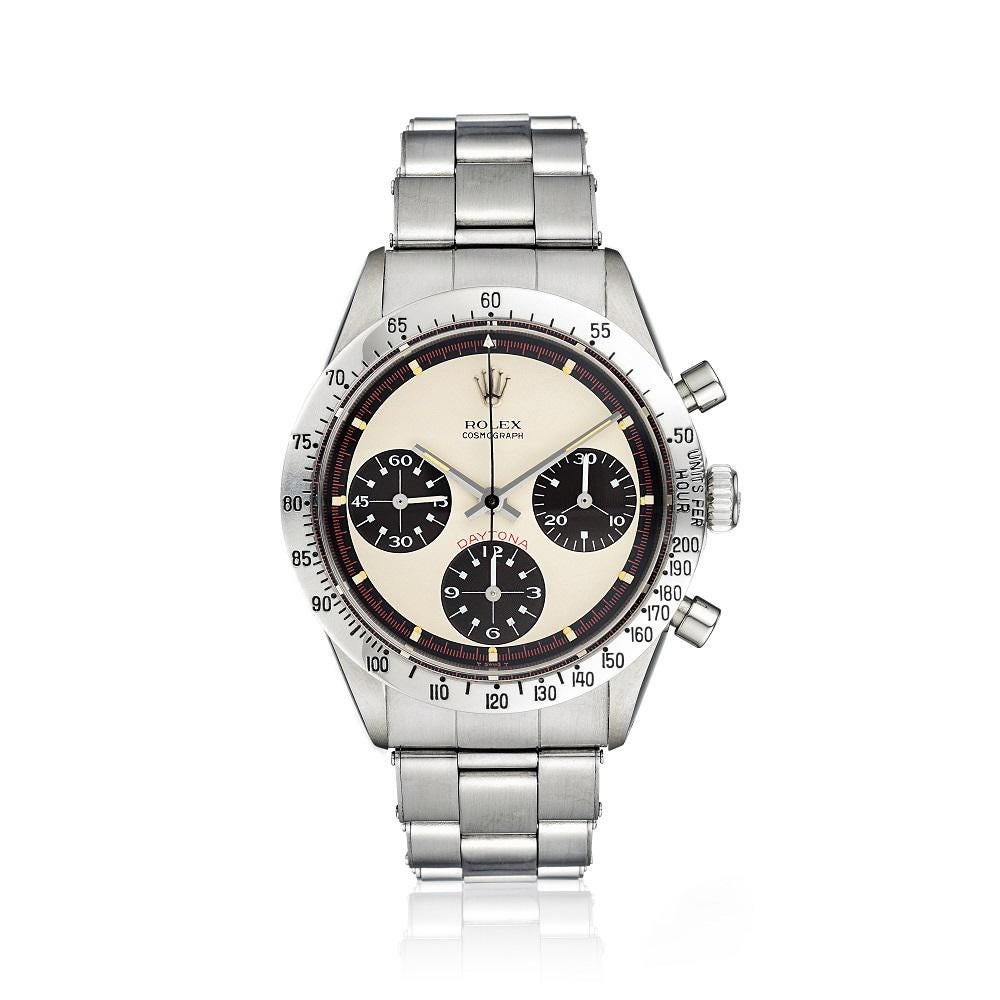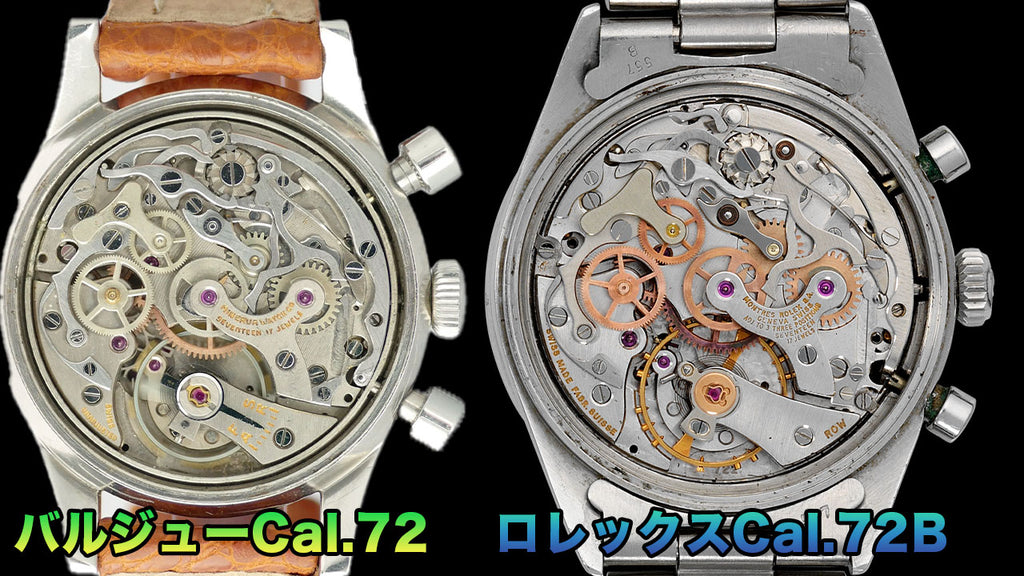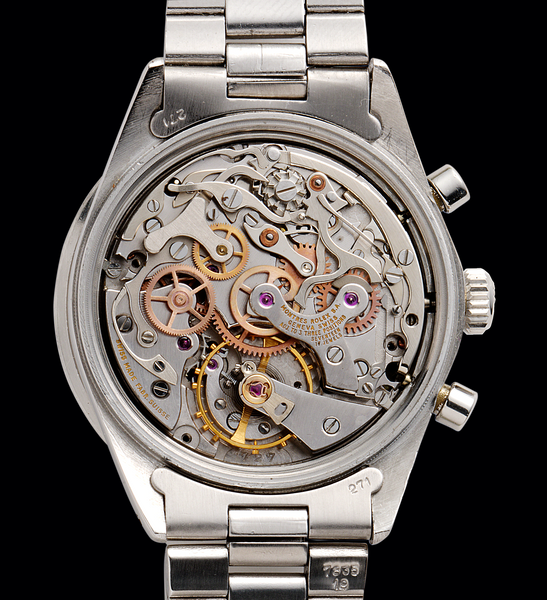What kind of watch is the Rolex Daytona "Paul Newman"? The first generation ref. 6239 and 6241
Click here to watch a video about Paul Newman's watch.
Of all Rolex Daytona models, it is safe to say that the one that attracts the most attention and excitement is the Paul Newman model.
But what is it about this watch that has Rolex enthusiasts so excited?
Although the Paul Newman Daytona is out of the reach of many collectors' budgets, it is still a fun watch to examine and learn about.
This article aims to provide a bit more clarity about what many consider to be the greatest watch on the planet: the Daytona.
What makes the Daytona ref. 6239 the Paul Newman Rolex?
What are its characteristics?
I will explain these things, but I think that by the time you finish reading this article you will have a certain level of understanding about Paul Newman, so please stick with me until the end.
What is the Rolex Daytona "Paul Newman"?

The Paul Newman design was derived from the Daytona, and as we will explain in more detail later, it was named after the actor and racer Paul Newman, who wore the watch while racing.
By the way, Paul Newman was a nickname, and at the time, Rolex called this special dial the "exotic dial."
However, it is not true that Paul Newman films are still being made today.
This model was produced from 1963 to 1972, but has not been produced since then.
So, this is a dial that is only found on vintage watches.
During this period, up to the third generation was born, and to be precise, there are also derivatives, but for ease of understanding, we will divide them into these two patterns here.
The two patterns differ in the material of the bezel.
The first has a stainless steel case and the second has a black plastic bezel.
Please see the image below↓

The top bezel is steel and the bottom bezel is plastic.
Then, from left to right, we move on to the 1st to 3rd generations.
Here we see the Paul Newman models up to the third generation, of which two bezels were available for each generation.
So let's take a look at the differences between the regular model and the Paul Newman model.

The one on the left is the Paul Newman model and the one on the right is the regular model.
At first glance, you probably won't notice any differences, but there are four easy ways to tell it apart from the regular Daytona version.
Please see the image below.

Firstly, there is a cube-shaped marking extending from the line inside the inner dial.
Secondly, the numbers on the sub-dial have a distinctive design that is different from the typical Arabic numerals that were popular during the Art Deco period.
The third feature is the cube-shaped indexes attached to the outer circumference, which are consistent with the sub-dials.
The fourth problem is that the sub-dial displays 15, 30, 45, 60 instead of 20, 40, 60.
The main differences are the four points above, and if you know them, I think you'll be able to easily distinguish it from the regular model.
The production period was from 1963 to 1972, which was a short period, and even then, only about 30% of the Paul Newman models were produced.
The movement used in the first to third generations was a converted mechanical movement, Valjoux Cal. 72, and from the fourth generation onwards, Zenith's El Primero was used.
I'll explain the movement in more detail later.
Exotic dials can be found on these six vintage Rolex Daytona chronographs:
The references up to the third generation are summarized below.
First generation
- Rolex Daytona ref. 6239
- Rolex Daytona ref. 6241
Second Generation
- Rolex Daytona ref. 6262
- Rolex Daytona ref. 6263
Third Generation
- Rolex Daytona ref. 6264
- Rolex Daytona ref. 6265
These watches also come in two dial variations; white and black.
Price: (minimum) $100,000 to $17.8 million
Approximately 10 to 18 million yen at an exchange rate of 100 yen to the dollar
Prices vary depending on the condition, so there is a wide range.

Why are there so few "Paul Newman" models?
Since the 1960s, Rolex has offered a variety of unusual dials for its Daytona chronographs.
Called an "exotic dial" in the Rolex catalogue, its beauty sets it apart from the standard Daytona dial, with a stepped minute track and Art Deco-style font on the chronograph register.
Today, these exotic dials are collectively known as "Paul Newman" dials, and Rolex chronographs equipped with these are called "Paul Newman Daytonas."
Here we will explain the origin of the name.
In fact, these exotic dials were not very popular during this period.
For this reason, customers who purchased a Daytona often opted for the regular dial design.
Therefore, as mentioned above, Rolex will reduce the production of exotic dials and focus on producing regular dials.
As a result, these exotic dials are extremely difficult to come by today, and for vintage Rolex collectors, the dials alone are enough to fetch high prices.
Due to scarcity and current high demand, it may not be easy to come across an authentic vintage Rolex Daytona with an exotic dial in good condition.
However, while the price difference between a regular Daytona model and an exotic dial Daytona is huge, it's important to understand that the difference between the two is purely cosmetic.

Paul Newman's Daytona Ref.6239

Now, from here on, I will not be talking about the Paul Newman model, but about the Reference 6239 that Paul Newman actually used.
Introduced in 1963, the ref. 6239 was the first Rolex Daytona model, and was the one Paul Newman actually wore .
The one on the left is the same model worn by Paul Newman himself, and the one on the right is the model with a contrasting black dial.

The Rolex ref. 6239 worn by Paul Newman himself was a "tri-color" watch with a white dial with black chronograph registers and contrasting red accents, but it was also produced with a black exotic dial with white registers and a red minute track running around the outer edge of the dial.

Source: Christie's
In both dial variations, the DAYTONA logo above 6 o'clock is also red, and the fixed metal bezel is engraved with a tachymeter scale.

Movements used in the first to third generations of Daytona
As for the Daytona, of course it is now equipped with an in-house caliber, but before that it was equipped with Zenith's El Primero.
The first three generations were equipped with a converted mechanical caliber, Valjoux Cal. 72.
I'm sure that those reading this article already know this, but just to explain, Valjoux is a prestigious manufacturer of chronograph movements, and provides mechanical chronographs to a variety of brands.
That includes Patek Philippe.
In this way, the common way of making chronographs in the era of mechanical watches was to receive the movement from the ébauche maker and then tweak it a bit in-house.
The masterpiece of the two-register version of Valjoux is the Cal. 23, and the masterpiece of an in-house conversion of this 23 is Patek Philippe's Cal. 13.

Source: REVOLUTION
It's a fairly high-end watch, but it's based on the Cal.23 movement.
So, Cal. 72 was created by adding a 12-hour counter to Cal. 23, and Rolex converted this movement to create their new Cal. 72B.
Now, please see this image↓

At first glance they look almost the same, but what makes it different from the Cal. 72 is that the regulator pin installed on the balance cock has been removed, and instead a microstella screw for rate adjustment has been added to the regulation screw on the balance wheel.

It may be a little difficult to see, but the two areas circled in red are the ones in question.
You can see that the threads are longer than the others.
This is a method of adjusting the advance or delay by changing the specific gravity balance of the balance wheel.
By the way, the bridge supporting the balance wheel has the engraving ROW, which is the Rolex Werke mark and indicates that this movement was specially made by Rolex.
It is said that production of the Caliber 72B lasted from around 1960 to 1967.
The next movement to be born was the Cal. 722-1.

*Rolex Cal.722-1
The basic design is the same as Cal.72B, but the difference is that a plate is attached between the adjacent bridge to prevent the hairspring from getting tangled in the balance when a strong impact is applied.
The production period is said to be around 1967-69.
The next movement to be born was the Cal. 727.

At this time, the reference was changed and both the design and movement evolved into the next generation (the third generation).
This Cal. 727 was the mechanical chronograph movement that Rolex used in its Daytonas until the end, and is said to be their masterpiece.
The basic design of the 727 is the same as the 722-1, but there are two major changes.
The first thing is that it has evolved from Incabloc to Kif Ultraflex.
The second change is that the balance spring has been changed to an alloy, improving magnetic resistance.
In addition, the plate that was in the previous model to prevent the mainspring from getting tangled has been removed, and the movement has been changed to one that is more durable thanks to improved materials.
In addition, although it is difficult to see from the image, the diameter of the balance wheel has been slightly reduced, and in order to make up for this in terms of vibration frequency, it has been increased from 18,000 vibrations per hour to 21,600 vibrations per hour.
The production period was from 1969 to 1988.
Generally, automatic chronographs were born in the 1970s, so the mechanical chronograph movements that were used until 1988 may look old, but they have a history of continuing to evolve, and the movement in Rolex's Daytona is an excellent movement in both functionality and structure.
1.7 billion Rolex watches
An identical Paul Newman Daytona watch that Paul Newman himself used for many years was put up for auction in 2017, and at an exchange rate of 100 yen to the dollar, it sold for a whopping 15.5 million dollars (approximately 1.5 billion yen).
Taking into account the buyer's premium, the total price comes to $17.8 million (approximately 1.7 billion yen).
Isn't it a mistake and it's 17.8 million yen?
Some of you may be thinking that, but the actual number is 1.5 billion.
This is the watch that Paul Newman himself used.
At the time of the sale, the actor's Daytona was the most expensive watch ever sold at auction.
Legend has it that Newman's personal Daytona was given to his daughter Nell Newman's former boyfriend, James Cox, in the 1980s.
The watch remained in his possession until it was sold by Phillips Auction House in 2017, with a portion of the proceeds going to the Nell Newman Foundation.
Because we know its provenance, we can prove that it is the watch used by Paul Newman himself.
Rolex Daytona 6239 Price and Summary
As mentioned above, it's nearly impossible to predict how much a particular Rolex 6239 will fetch on the secondary market, as factors such as dial color, condition, and whether or not it has the original box and papers will all play a major role in overall resale value.
However, if the watch is still in good condition, it would almost certainly be worth at least a billion yen.
The Vintage Rolex Daytona Paul Newman Edition has had a fantastic history so far and I think it speaks to the strength of Rolex in starting out rocky but finishing triumphantly.

There is no doubt that this is not a watch that anyone can buy, but just knowing the story of one Rolex model like this and understanding its design features will broaden your view of watches.
There is certainly joy in owning one, but I believe that knowing the history of one of Rolex's signature models, a company that reigns at the top of the watch industry, will allow you to enjoy watches as a whole even more.



